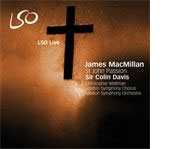James MacMillan: interview about his St John Passion

James MacMillan discusses his setting of the St John Passion, recently released on disc and receiving its first German and Dutch performances this Easter.
What drew you to compose a St John Passion?
St John’s version of the Passion story is the one I know the best, because it is recited or chanted every Good Friday as part of the Catholic liturgy. I myself have taken part in this most years since I was a student at Edinburgh University, chanting the Gregorian and Dominican musical settings. John, of course, was one of the original disciples, a beloved friend of Jesus, who took Christ’s mother into his own home after the crucifixion. He was an eye witness to these events and seemed to have a profound inside understanding of what happened, and the spiritual significance of Christ’s words, from his astonishing court-room battle with Pilate to his last utterances on the Cross. This aspect is also apparent in Bach’s St John Passion, and is the reason why this is my favourite among all his works.
How does the narrative unfold?
There are two choirs. A small chamber choir tells the story and carries the Narrator’s words. Its music is plainsong influenced, and has a certain detachment from the drama. Jesus is a solo baritone – the only soloist. His lines are full of decorations and melismas, and in his own way, he seems apart from the convulsions unfolding around him. The large choir represents all the other voices – of the crowd, of servants, the Pharisees, Pontius Pilate, St Peter and so on. At the end of most movements the large choir are given a Latin motet to sing. These texts are from Good Friday liturgies, or elsewhere. They provide reflection points where we can step outside the drama and look sideways at it, from a different perspective. For example, Part One ends with the Crucifixus section from the Credo, from the Ordinary of the Mass.
There are further interpolations in Part Two, which increasingly emphasise the inner drama, including settings of the Stabat Mater and the Reproaches.
The Stabat Mater ends the section with Jesus and his Mother, depicting Mary’s reaction to the Crucifixion. Yet again an important and famous text from the Good Friday experience seemed to suggest itself at the appropriate point. After the heartbreaking dialogue with his Mother on the Cross, I introduce this text which focuses on the very human feelings of a mother’s grief at the calamity which has befallen her son.
I set the Reproaches as a separate ‘aria’ for Christ, with interpolations from the choir. The Reproaches are antiphons and responses from the Good Friday liturgy. Palestrina’s setting is still sung in the Sistine Chapel every Good Friday. The texts ascribed to Jesus in this are mostly taken from the Old Testament (the books of Isaiah, Micah and Jeremiah), and were written before and during the Exile in Babylon. Parallels are drawn with the wandering through the Wilderness in the book of Exodus and the Passion narrative.
What interpretation do you make of the Reproaches?
My experience at Good Friday services was that the Reproaches turned the liturgy outwards towards the congregation, and I wanted something similar at the point before Jesus’s death in the Passion. The words of Christ question the rejection of God: “My people, what have I done to you? How have I offended you? Answer me!” “My people” here means all people, in the New Testament sense – you, me, everyone in the world. At some level we all take responsibility for Christ’s seeming rejection. In the Catholic liturgical context the Reproaches are a prayerful device which allows the people present to reflect on their own fallenness, their own unfaithfulness and sin. Up to this point in my work Christ has been a traditionally passive participant in the narrative, but in this movement I tried to make him come alive as a human being with real emotions and feelings.
Christ’s death is followed by a final orchestral movement.
The final movement, after all the words have been sung, is a Song without Words – no text could suffice here – it is left to music alone to explore the deeper tragedy which has just unfolded. The translation of this final title is ‘Holy Immortal One, have mercy on us’. Again it is taken from the Reproaches, and it is meant to be a kind of prayer, or benediction after all the violence and sorrow.
Listen to the St John Passion in our audio-visual area.

